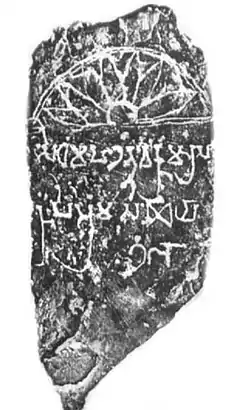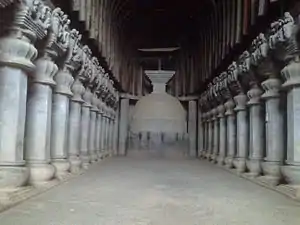Rupiamma
Rupiamma was a Great Satrap in India during the 2nd century CE, who is known from an inscription found at Pauni in Central India, south of the Narmada river.
Pillar inscription
A memorial pillar with an inscription in the name of "Mahakshatrapa Kumara Rupiamma" has been recovered in Pauni,[3] and is dated to the 2nd century CE.[4] Rupiamma is probably related to the Saka Western Satraps.[4] This memorial pillar is thought to mark the southern extent of the conquests of the Western Satraps, much beyond the traditionally held boundary of the Narmada River.[4] The use of the word "Kumara" may also mean that Rupiamma was the son of a Great Satrap, rather than holding the title himself.[5]
The Middle Brahmi inscription reads:[6][7]
𑀲𑀺𑀥𑀁 𑀫𑀳𑀔𑀢𑁆𑀢𑀯 𑀓𑀼𑀫𑀭𑀲 𑀭𑀼𑀧𑀺𑀅𑀁𑀫𑀲 𑀙𑀬𑀸 𑀔𑀁𑀪𑁄
Sidhaṃ Mahakhattava Kumarasa Rupiaṃmasa chayā Khambo
"Sculpted pillar of Lord Prince and Great Satrap Rupiamma"— Rupiamma inscription, 2nd century CE[4]
Coinage

There are no coins of Rupiamma known, but coins belonging to the Western Satraps (Rudrasimha) were also discovered in the ruins of Buddhist stupas at Pauni.[8][9][10]
A few dozen donative inscriptions in the Brahmi script have been found at the site of Pauni, in a style similar to the inscriptions of Bharhut and Sanchi.[11]
Kushan or Western Satrap?
It is not known is Rupiamma, as a "Great Satrap", should be understood as a representative of the Kushan Empire, or as one of the Western Satraps, whose own political relationship with the Kushan is not clearly known. If Rupiamma belonged to the Kushan hierarchy, this would suggest that Kushan control extended this far south, beyond the generally accepted southern boundary formed by the Narmada river.[12] According to the recently discovered Rabatak inscription, Kushan dominions expanded into the heartland of northern India in the early 2nd century CE. Lines 4 to 7 of the inscription[13] describe the cities which were under the rule of Kanishka, among which six names are identifiable: Ujjain, Kundina, Saketa, Kausambi, Pataliputra, and Champa (although the text is not clear whether Champa was a possession of Kanishka or just beyond it).[14][15][16][17]
References
- Indian Archaeology 1964-65 A Review. p. 58, item 40.
- Anon (2 October 2018). "Rupiamma pillar recent photograph". Zenondo. doi:10.5281/zenodo.1442623. Retrieved 25 January 2020.
- "Siddham. The Asian Inscription Database, Pauni (पवनी Bhandara district). Memorial Pillar (OBNAG0032) with Inscription (INNAG0031) of Rupiamma".
- Mirashi, V. V. (1965). "A Pillar Inscription of Mahakshatrapa Rupiamma from Pawni". Proceedings of the Indian History Congress. 27: 51–54. ISSN 2249-1937. JSTOR 44140583.
- "The pillar inscription of Rupiamma from Pauni (1-41) may present a similar example. In it, Rupiamma is described as Mahakhattava-kumära ; he is a son or prince of the mahäksatrapa; the title in itself is felt to be sufficient identification" Vienna Journal of South Asian Studies (in German). E.J. Brill. 1974. p. 21.
- Indian Archaeology 1964-65 A Review. p. 58, item 40.
- Anon (2 October 2018). "Rupiamma pillar recent photograph". Zenondo. doi:10.5281/zenodo.1442623. Retrieved 25 January 2020.
- "Excavation Pauni ASI Nagpur". excnagasi.in.
- "The numismatic evidence comprised coins of the Satavahana king Satakarni and those of the Kshatrapas." Indian Archaeology 1969-70 A Review. pp. 20–21.
mentioned in early Taina literature as one of the six important cities of ... with an embankment of brick
- Shastri, Ajay Mitra; Sharma, Raj Kumar; Handa, Devendra (2005). Revealing India's Past: Recent Trends in Art and Archaeology : Prof. Ajay Mitra Shastri Commemoration Volume. Aryan Books International. p. xxxiii. ISBN 978-81-7305-287-3.
- Salomon, Richard (1998). Indian Epigraphy: A Guide to the Study of Inscriptions in Sanskrit, Prakrit, and the other Indo-Aryan Languages. Oxford University Press. p. 142. ISBN 978-0-19-535666-3.
- Mukherjee, Bratindra Nath (1988). The rise and fall of the Kushāṇa Empire. p. 269. ISBN 9780836423938.
- For a translation of the full text of the Rabatak inscription see: Mukherjee, B.N., "The Great Kushana Testament", Indian Museum Bulletin, Calcutta, 1995. This translation is quoted in: Goyal (2005), p.88.
- For quotation: "The Rabatak inscription claims that in the year 1 Kanishka I's authority was proclaimed in India, in all the satrapies and in different cities like Koonadeano (Kundina), Ozeno (Ujjain), Kozambo (Kausambi), Zagedo (Saketa), Palabotro (Pataliputra) and Ziri-Tambo (Janjgir-Champa). These cities lay to the east and south of Mathura, up to which locality Wima had already carried his victorious arm. Therefore they must have been captured or subdued by Kanishka I himself." see: Goyal, p. 93.
- See also the analysis of Sims-Williams and J. Cribb, specialists of the field, who had a central role in the decipherment: "A new Bactrian inscription of Kanishka the Great", in Silk Road Art and Archaeology No. 4, 1995–1996. pp.75–142.
- Sims-Williams, Nicholas. "Bactrian Documents from Ancient Afghanistan". Archived from the original on 10 June 2007. Retrieved 2007-05-24.
- Rezakhani 2017b, p. 201.
Sources
- Rezakhani, Khodadad (2017b). "From the Kushans to the Western Turks". In Daryaee, Touraj (ed.). King of the Seven Climes: A History of the Ancient Iranian World (3000 BCE - 651 CE). UCI Jordan Center for Persian Studies. pp. 1–236. ISBN 9780692864401.



